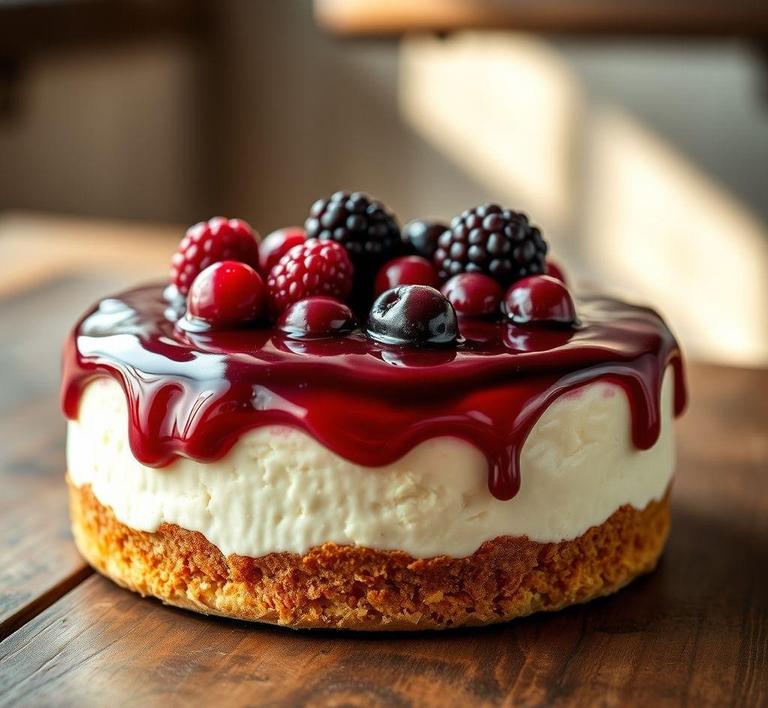Have you ever made a cheesecake and had leftovers, or maybe you just want to make it ahead of time? Refreezing cheesecake can be a bit tricky, but with the right technique, you can preserve its delicious texture and flavor for later enjoyment. Whether you have a store-bought cheesecake or one you’ve crafted yourself, knowing how to properly refreeze it ensures it stays creamy and satisfying when you’re ready to indulge. This guide will walk you through the best practices for safely refreezing cheesecake so you can enjoy it at its best!
Can You Refreeze Cheesecake?

The short answer is yes, you can refreeze cheesecake, but with some important caveats. Cheesecake, like many other delicate desserts, can be stored in the freezer to extend its shelf life. However, once thawed and then refrozen, its texture and flavor can be altered in ways you might not want. Let’s break down why this happens and how it affects the cheesecake.
Cheesecake is primarily made of cream cheese, eggs, sugar, and sometimes sour cream or other dairy ingredients, which gives it its smooth, creamy texture. These ingredients, when frozen, undergo a change in structure. Water content in the cheesecake forms ice crystals, and when the dessert is thawed, the water may not fully recombine into the original structure, which can result in a slight graininess or separation in texture.
When you refreeze a cheesecake after it’s been thawed, you’re effectively subjecting it to multiple freeze-thaw cycles, which can exacerbate this issue. But can it be done? Absolutely. However, it’s best to be mindful of the quality impact, as some of the original creamy texture will inevitably be lost.
How To Refreeze Cheesecake?
Refreezing cheesecake is a delicate process, and if you’re determined to do so, following the right steps will help preserve its quality as much as possible. Here’s how to go about it:
1. Ensure It’s Properly Thawed First
Before thinking about refreezing your cheesecake, ensure that it’s been thawed slowly and evenly. The best method is to let it thaw in the refrigerator for 24 hours, as this will allow the cheesecake to regain some of its texture. Avoid thawing it on the counter, as rapid temperature changes can create moisture condensation, which can make the cheesecake soggy or unevenly thawed.
2. Prepare It For Refreezing
After it’s been properly thawed, assess the texture. If there’s any noticeable separation of liquid, gently blot it away using paper towels. This step will help you avoid reintroducing excess moisture into the cheesecake, which could make the refrozen dessert even more compromised.
If the cheesecake is in individual slices, consider wrapping each slice in plastic wrap to minimize air exposure. For whole cheesecakes, you can wrap the entire dessert tightly in plastic wrap, followed by a layer of aluminum foil for extra protection. A vacuum-sealed bag could also be an excellent option if you have one on hand, as it will eliminate air entirely.
3. Label And Date It
If you have multiple cheesecakes or other frozen foods, labeling and dating your cheesecake is crucial. This helps you track how long it’s been frozen, preventing it from being stored for too long. Ideally, cheesecake should be refrozen within a couple of days of thawing for the best results. After about a month or two, the texture and flavor could significantly degrade.
4. Freeze It In A Freezer-Friendly Container
Once wrapped, place the cheesecake or cheesecake slices in an airtight container that is suitable for freezing. This will prevent freezer burn and help maintain the quality of the dessert. Make sure to place the cheesecake on a flat surface in the freezer to avoid any unintended shape alterations.
5. Allow For A Slow Thaw After Refreezing
When you’re ready to eat the cheesecake, the best way to thaw it is slowly in the fridge. Ideally, you want to thaw the cheesecake for 24 hours, just as you did the first time around. While it may be tempting to rush the process, thawing it too quickly or at room temperature can result in a soggy or unevenly textured dessert.
Quality Impact
Refreezing cheesecake, while doable, will certainly affect the final product in terms of texture and flavor. Here’s how:
1. Texture
Cheesecake’s signature smooth and creamy texture is one of the main reasons people love it. However, when frozen, ice crystals form inside the dessert, disrupting this creamy texture. Upon thawing, the water that was previously frozen can cause the filling to separate or become grainy. Refreezing adds another layer of disruption to the structure, often resulting in a looser, more watery consistency when thawed the second time.
This is particularly noticeable if the cheesecake has been topped with fruit or other moist ingredients, as the freezing and thawing process can cause these toppings to become mushy or soggy.
2. Flavor
Cheesecake flavors might also suffer from the freeze-thaw process. The flavors can become muted, or some delicate notes from vanilla or citrus may become less pronounced. Additionally, the toppings, especially if they are fruit-based, may lose some of their original freshness or sweetness. The cheesecake filling itself can also experience a slight change in flavor after multiple freezing cycles.
3. Freezer Burn
If not properly wrapped or stored, the cheesecake is prone to freezer burn, which is when the dessert develops dry, tough spots due to air exposure in the freezer. This can make the dessert less appealing in both taste and texture.
While it is technically possible to refreeze cheesecake, doing so is not without consequences. The key takeaway here is that cheesecake is best enjoyed after a single freeze-thaw cycle. Refreezing cheesecake can lead to a noticeable deterioration in its texture and flavor, making it less appealing than when it was first made or originally frozen.
If you absolutely have to refreeze cheesecake-perhaps because you have leftovers that you want to save-ensure that it is properly wrapped and stored to minimize the impact. But, if you’re aiming for the highest quality experience, it’s always best to enjoy your cheesecake soon after thawing and avoid the temptation to refreeze.
Is It Safe To Refreeze Cheesecake?
Refreezing cheesecake is a nuanced issue that can be a bit tricky. While it is technically safe to refreeze cheesecake, it depends largely on how it was initially frozen and handled throughout the process. Cheesecake is a delicate dessert, with a rich, creamy texture that could be affected by refreezing, potentially leading to a less-than-ideal result.
The key factor in determining whether cheesecake can be safely refrozen is its initial freezing. If you froze it properly, without any interruptions or improper handling, refreezing can be done without a significant loss in quality. The first freezing should have been done swiftly, ideally within two hours of baking, and the cheesecake should have been wrapped tightly in plastic wrap and foil or placed in an airtight container. This helps prevent freezer burn and moisture loss, which can negatively impact its texture when refrozen.
However, while it’s possible to refreeze cheesecake, it’s important to note that every freezing and thawing cycle contributes to a gradual degradation of its quality. The creamy consistency of cheesecake can start to break down, leading to changes in texture and flavor after multiple freezes. Refreezing can cause the crust to become soggy, and the filling may separate or take on a grainy, watery texture. Therefore, while it’s safe from a food safety perspective, it’s not always the best choice for preserving the integrity of the cheesecake.
Signs That Cheesecake Should Not Be Refrozen
There are several signs to look for that indicate your cheesecake is no longer suitable for refreezing. These indicators can help you determine if the cheesecake has undergone enough changes that it might not be worth the effort to try and refreeze it.
- Excessive Thawing: If the cheesecake has already been thawed out for more than a few hours, it has likely undergone some significant texture changes. Extended thawing causes moisture to accumulate, and once that moisture is refrozen, the cheesecake may become soggy or lose its smooth texture. If the cheesecake has been left at room temperature for too long, or if it was thawed in an uncontrolled environment like a warm kitchen, it is best not to refreeze it.
- Visible Separation: If the filling of the cheesecake has started to separate or become watery, this is a strong sign that the texture has already been compromised. Cheesecake’s creamy texture relies on a smooth, homogeneous mixture, so if the filling looks uneven or you notice liquid pooling, refreezing will likely result in a less-than-pleasant outcome.
- Freezer Burn: Freezer burn occurs when food is exposed to air in the freezer, causing dehydration and oxidation. If your cheesecake has ice crystals on its surface, or the edges look frosted or discolored, it’s a clear sign of freezer burn. Refreezing cheesecake that has freezer burn will only exacerbate the dryness and loss of flavor.
- Off Odor: Cheesecake, like any dairy-based dessert, can spoil if left in the freezer for too long or stored improperly. If you notice any sour, rancid, or off-putting smells when you thaw it, this is a sign that the cheesecake has gone bad and should not be refrozen.
Common Refreezing Mistakes
Even if you decide to refreeze your cheesecake, there are a few common mistakes that can make the process go wrong, affecting the final product’s taste and texture. Here’s a breakdown of what to avoid:
- Improper Wrapping: One of the biggest mistakes is not wrapping the cheesecake tightly enough before freezing. Cheesecake is very susceptible to freezer burn and flavor loss, so it’s crucial to wrap it in plastic wrap, followed by a layer of foil, or to use an airtight container. If air gets in, the cheesecake will dry out, and the texture will degrade, especially after refreezing.
- Refreezing Multiple Times: Refreezing the cheesecake more than once can cause significant damage to its texture. Each time the cheesecake is frozen and thawed, moisture is lost, and the creamy consistency is compromised. The best practice is to freeze it once, and if necessary, thaw only the portion you plan to eat. If you refreeze the entire cheesecake multiple times, the result may be a watery, grainy mess.
- Thawing Too Quickly: Fast thawing, like leaving the cheesecake out at room temperature for several hours, can cause the cheesecake to soften too much, resulting in a compromised texture when refrozen. Instead, thaw the cheesecake slowly in the fridge. This helps it retain its structure and ensures it refreezes in a much better state.
- Refreezing Leftovers in a Single Layer: If you’re only refreezing a portion of the cheesecake, avoid simply putting the leftovers in the freezer in a single layer. This increases the risk of freezer burn. Instead, cut the cheesecake into slices, wrap each slice individually, and freeze them separately to maintain the quality of each piece.
Tips And Tricks
If you decide to refreeze cheesecake, there are a few tricks that can help preserve its taste and texture, giving you a better result:
- Freeze Quickly: If you know you’re going to freeze the cheesecake, do so as soon as possible after it’s baked or bought. The faster it freezes, the less likely it is to lose its texture. Ideally, freeze it within two hours of baking to maintain its freshness.
- Use a Layer of Protection: To prevent freezer burn, use both plastic wrap and aluminum foil when wrapping the cheesecake. The plastic wrap should be in direct contact with the surface to prevent moisture from escaping, while the foil protects it from air exposure and helps keep the flavor intact.
- Slice Before Freezing: If you know you won’t eat the entire cheesecake in one sitting, it’s best to slice it before freezing. Freezing individual portions will help preserve the texture and make for easier thawing later on. Just wrap each slice securely and freeze them separately.
- Thaw Gradually: When you’re ready to enjoy your cheesecake again, avoid thawing it too quickly. The best method is to place it in the fridge overnight to thaw slowly. This prevents the cheesecake from losing too much moisture and maintains the creamy texture.
- Serve Cold: Cheesecake is typically served cold or at room temperature. If you’re refreezing, you might find that the cheesecake tastes best when slightly chilled, rather than being brought all the way back to room temperature. The cool temperature helps maintain the integrity of the creaminess, even if it’s been refrozen.
Conclusion
Refreezing cheesecake can be a bit of a gamble when it comes to texture and flavor, but it’s not entirely off the table. The key to safely refreezing cheesecake lies in how it’s initially frozen and how carefully you handle it during the process. While it may not ever return to its original, freshly made state, with proper precautions, refreezing can allow you to enjoy your cheesecake again without sacrificing too much quality.
Pay attention to signs of spoilage, avoid common refreezing mistakes, and make use of helpful tips to ensure the best possible outcome. By freezing quickly, wrapping securely, and thawing slowly, you can preserve the deliciousness of your cheesecake and reduce the risk of ruining this indulgent treat.


